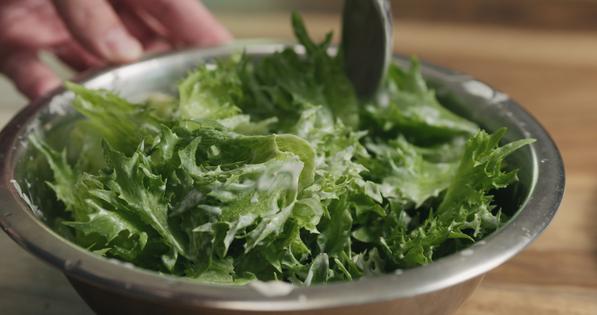New take on Caesar salad shows dish's versatility
What makes a recipe food lovers refer to as a classic? It has to taste delicious and, of course, look beautiful. It should satisfy the other senses, too, offering enticing aromas, pleasing textures, and even delightful sounds. A classic should also stand the test of time, regardless of whatever food fads may come or go.
I'd like to add another qualification: A classic must be so good that it's also versatile, leaving room for some creativity. Professional chefs and home cooks alike come to appreciate the ability such dishes have to seem fresh and new when we want them to.
By such standards, Caesar salad certainly counts as a classic. The improvised creation of restaurateur Caesar Cardini, who whipped it up late one evening in 1924 from odds and ends in his kitchen in Tijuana, Mexico, the dish has long since become a worldwide favorite: a simple yet complex-tasting assemblage of crisp, chilled Romaine lettuce; garlicky croutons; and a rich dressing of egg, garlic, olive oil, Dijon mustard, Parmesan and a hint of canned salted anchovy fillets, which may also be added whole as a garnish.
Restaurant guests today have long since grown accustomed to enjoying Caesar salad as a dinner appetizer or lunchtime main dish, the latter frequently topped with grilled seafood, chicken or steak. I've seen several variations: low-fat Caesars in which the dressing's egg is replaced by creamy, fat-free Greek yogurt; Southwestern Caesar salads seasoned with smoky dried chipotle chilies; and trendy Caesars in which raw kale replaces the Romaine. And, if they're made with culinary know-how, they all work, as smart variations on a classic often do.
In that spirit, I'd like to share one of my own spins on Caesar salad; this one inspired by the cuisine of southern France, where I spent some of my formative years as a chef cooking under the late, great Raymond Thuilier at his famed, Michelin-starred L'Oustau de Baumaniere. This version keeps the lettuce and dressing largely unchanged. Its departure from tradition comes in the croutons.
Instead of the usual bread cubes, I start with wider, bite-sized pieces. Before baking, I toss them not only with garlic, olive oil and Parmesan, but also fragrant fresh herbs you might find growing on a Provencal hillside. Then, just before serving, I spread each crouton with tapenade, the classic olive spread of the region, for which I offer an easy, delicious recipe here. Combined with the cold lettuce and fragrant dressing, it all adds up to a Caesar salad that tastes both unmistakably authentic and surprisingly different.
I hope you enjoy this version, which makes a perfect springtime or summer recipe. May it also inspire you to come up with your own variations on a classic!
PROVENCAL CAESAR SALAD WITH TAPENADE CROUTONS
Serves 2 to 4
For the tapenade croutons:
...continued
(c) 2019 WOLFGANG PUCK WORLDWIDE, INC. DISTRIBUTED BY TRIBUNE MEDIA SERVICES, INC.










